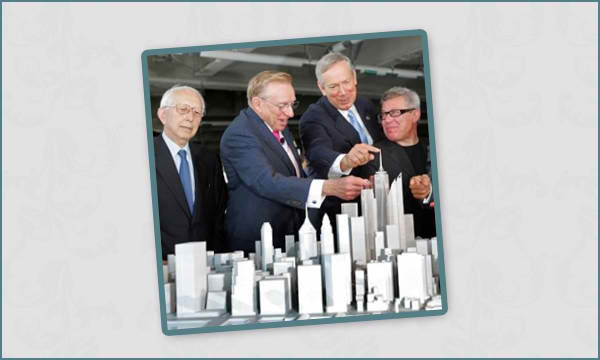Sacred Ground

Sacred Ground was a commission by US broadcaster PBS. It was a co-Production between Vivum, PBS Frontline and British broadcaster Channel 4.
It charted the tense battle for control of the iconic project to rebuild the World Trade Center. The documentary managed to gain access to all the key players, something which was not done before or since – four of them are pictured above. The film contains interviews with the building’s developer, Larry Silverstein, the architect charged with developing a masterplan, Daniel Liebeskind, the Governor of New York at the time, and the architect who eventually gained control of the project, David Childs of mega-corporate architecture firm, SEO.
We also managed to interview Roland Betts, known as the First Buddy, who was the President’s personal representative in New York overseeing the project.
REVIEWS
Associated Press, Frazier Moore
“… Telling and poignant, this ‘Frontline’ documentary exposes the contentious first year of the rebuilding effort on the World Trade Center site. …”
TV Guide, Susan Stewart
“A fascinating study in realpolitik… It’s too early to judge their unbuilt project but Ground’s coverage of the planning process is a clear winner.”
Boston Globe, Sam Allis
“… With ‘Sacred Ground,’ which opens the new season for the PBS documentary series tonight, ‘Frontline’ returns in fine form. … It is fascinating in the way a train wreck is fascinating. We may have been vaguely aware from media reports of this slugfest, but few of us had any idea of its brutality. It is a cautionary tale without winners, and a primer in how not to design an American icon. …”
Atlanta Journal-Constitution, Catherine Fox
“… ‘Frontline’s portrayal is David vs. Goliath, only nobody quite wins. Central casting couldn’t have two better leads. …”
Rocky Mountain News, Mary Voelz Chandler
“… aptly named and timely. … Grade: A.”
Newsday, Noel Holston
“… enlightening, occasionally touching and, at the end, distressing…”
Pittsburgh Post-Gazette, Patricia Lowry
“… For the most part, the documentary doesn’t deal with the finer points of Libeskind’s master plan and the many innovations of the Nordensen-Childs design. Still, by focusing on the clash of egos and personalities, it’s good television and excellent insight into the public-private, push-pull process of how buildings get made in a capitalist democracy.”
New York Post, Adam Buckman
“… The story of the Freedom Tower is so complex that the producers of ‘Frontline’ don’t even raise relevant ancillary topics. These include the emotional selection process under which a design for an accompanying memorial was chosen, and the disposition of all those other towers seen in the various scale models of the WTC site that are supposed to sprout up alongside the Freedom Tower.
Addressing these other plot points might have made for a more comprehensive edition of ‘Frontline,’ but the producers can be forgiven for focusing only on the so-called Freedom Tower.
That’s the building that has garnered the most headlines. In addition, the story of that building is complicated enough, and ‘Frontline’ has only one hour in which to tell it.
And tell it they do with a series of interviews that are striking for their candor — not to mention their name-calling. …”
New York Daily News, David Bianculli
“… Like almost every other documentary about that site and that tragedy, ‘Sacred Ground’ will leave you feeling sadder than when you started watching. …
The power of ‘Sacred Ground’ comes from the fact that it’s filmed during the process, not comfortably afterward, and catches all the private bickering behind the amiable public posturing. …
When it’s over, you’ll long for what might have been. Before that, if you look carefully at some of the scale models, you’ll witness what should have been, and it may take your breath away.”
Chicago Tribune, Blair Kamin
“If you’re looking for a fly-on-the-wall view of one of the nastiest architectural catfights in recent memory, be sure to watch Tuesday’s ‘Frontline,’ which charts the tumultuous first year in the rebuilding effort at ground zero. …
What’s fresh and, at times, shocking is the unvarnished, behind-the-curtain look at their forced collaboration on the skyscraper…
This is like watching sausages get made or seeing an arranged marriage descend into intense recrimination and spiral toward divorce.
It would all be wonderfully entertaining were it not for the fact that nearly 3,000 people died at ground zero and the redevelopment is among the most complex and significant design challenges of the early 21st Century. The saga is, at least, instructive, illuminating the conflict between civic agendas and commercial pressures that shape the built environment of every American city, including Chicago. … “
Los Angeles Times, Christopher Knight
“New York Gov. George E. Pataki might want to be president someday. As if the aspiration for ultimate authority were not enough, he also harbors an apparent hankering to be an architect.
That disconcerting desire emerges near the close of tonight’s edition of ‘Frontline’ on PBS. The grim if revealing hour charts the epic struggle over the design of a Manhattan skyscraper planned to replace the architecturally undistinguished but emotionally compelling World Trade Center at ground zero. …”





